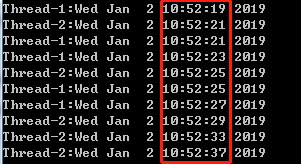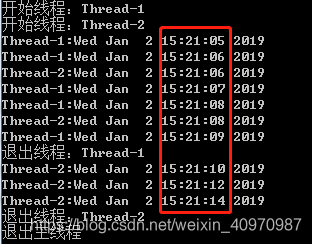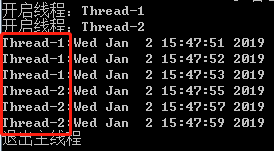进程和线程介绍
进程是并发程序执行过程中资源分配的基本单元,简单点说就是操作系统运行的一个任务。
线程是程序运行与调度的基本单元,简单点说就是进程的一个顺序执行流。
两者联系:
1、操作系统创建进程,进程创建线程;
2、线程没有独立的内存,进程有独立的内存;
3、线程共享该进程的所有内存;
4、CPU切换线程的速度比切换进程的速度快;
5、一个进程至少有一个线程
Python中使用线程
函数式创建线程
调用 _thread 模块中的start_new_thread()函数来产生新线程
import _thread
import time
def print_time(threadName,delay):
count = 0
while count < 5:
time.sleep(delay)
count += 1
print("%s:%s"%(threadName,time.ctime(time.time())))
#创建线程 _thread.start_new_thread ( function, args[, kwargs] )
try:
_thread.start_new_thread(print_time,("Thread-1",2,))
_thread.start_new_thread(print_time,("Thread-2",4,))
except:
print("Error:无法启动线程")
while 1:
pass
结果:

threading 模块创建线程
通过直接从 threading.Thread 继承创建一个新的子类,并实例化后调用 start() 方法启动新线程,即它调用了线程的 run() 方法
import threading
import time
exitFlag = 0
class myThread(threading.Thread):
def __init__(self,threadID,name,counter):
threading.Thread.__init__(self)
self.threadID = threadID
self.name = name
self.counter = counter
def run(self):
print("开始线程:" + self.name)
print_time(self.name,self.counter,5)
print("退出线程:" + self.name)
def print_time(threadName,delay,counter):
while counter:
if exitFlag:
threadName.exit()
time.sleep(delay)
print("%s:%s" % (threadName,time.ctime(time.time())))
counter -= 1
#创建线程
thread1 = myThread(1,"Thread-1",1)
thread2 = myThread(2,"Thread-2",2)
#开启新线程
thread1.start()
thread2.start()
thread1.join()
thread2.join()
print("退出主线程")
结果:

线程模块
Python3 通过两个标准库 _thread 和 threading 提供对线程的支持。
_thread 提供了低级别的、原始的线程以及一个简单的锁,它相比于 threading 模块的功能还是比较有限的。
threading 模块除了包含 _thread 模块中的所有方法外,还提供的其他方法:
threading.currentThread(): 返回当前的线程变量。
threading.enumerate(): 返回一个包含正在运行的线程的list。正在运行指线程启动后、结束前,不包括启动前和终止后的线程。
threading.activeCount(): 返回正在运行的线程数量,与len(threading.enumerate())有相同的结果。
除了使用方法外,线程模块同样提供了Thread类来处理线程,Thread类提供了以下方法:
run(): 用以表示线程活动的方法。
start():启动线程活动。
join([time]): 等待至线程中止。这阻塞调用线程直至线程的join() 方法被调用中止-正常退出或者抛出未处理的异常-或者是可选的超时发生。
isAlive(): 返回线程是否活动的。
getName(): 返回线程名。
setName(): 设置线程名。
线程同步
如果多个线程共同对某个数据修改,则可能出现不可预料的结果,为了保证数据的正确性,需要对多个线程进行同步。
使用 Thread 对象的 Lock 和 Rlock 可以实现简单的线程同步,这两个对象都有 acquire 方法和 release 方法,对于那些需要每次只允许一个线程操作的数据,可以将其操作放到 acquire 和 release 方法之间。
锁有两种状态——锁定和未锁定。每当一个线程比如"set"要访问共享数据时,必须先获得锁定;如果已经有别的线程比如"print"获得锁定了,那么就让线程"set"暂停,也就是同步阻塞;等到线程"print"访问完毕,释放锁以后,再让线程"set"继续。
import threading
import time
class myThread(threading.Thread):
def __init__(self,threadID,name,counter):
threading.Thread.__init__(self)
self.threadID = threadID
self.name = name
self.counter = counter
def run(self):
print("开启线程:" + self.name)
#获取锁,用于线程同步
threadLock.acquire()
print_time(self.name,self.counter,3)
#解放锁,开启下一个线程
threadLock.release()
def print_time(threadName,delay,counter):
while counter:
time.sleep(delay)
print("%s:%s" % (threadName,time.ctime(time.time())))
counter -= 1
threadLock = threading.Lock()
threads = []
#创建新线程
thread1 = myThread(1,"Thread-1",1)
thread2 = myThread(2,"Thread-2",2)
#开启线程
thread1.start()
thread2.start()
#添加线程到线程列表
threads.append(thread1)
threads.append(thread2)
#等待所有线程完成
for t in threads:
t.join()
print("退出主线程")
结果:

线程优先级队列( Queue)
Python 的 Queue 模块中提供了同步的、线程安全的队列类,包括FIFO(先入先出)队列Queue,LIFO(后入先出)队列LifoQueue,和优先级队列 PriorityQueue。
这些队列都实现了锁原语,能够在多线程中直接使用,可以使用队列来实现线程间的同步。
Queue 模块中的常用方法:
Queue.qsize() 返回队列的大小
Queue.empty() 如果队列为空,返回True,反之False
Queue.full() 如果队列满了,返回True,反之False
Queue.full 与 maxsize 大小对应
Queue.get([block[, timeout]])获取队列,timeout等待时间
Queue.get_nowait() 相当Queue.get(False)
Queue.put(item) 写入队列,timeout等待时间
Queue.put_nowait(item) 相当Queue.put(item, False)
Queue.task_done() 在完成一项工作之后,Queue.task_done()函数向任务已经完成的队列发送一个信号
Queue.join() 实际上意味着等到队列为空,再执行别的操作
import queue
import threading
import time
exitFlag = 0
class myThread(threading.Thread):
def __init__(self,threadID,name,q):
threading.Thread.__init__(self)
self.threadID = threadID
self.name = name
self.q = q
def run(self):
print("开启线程:" + self.name)
process_data(self.name,self.q)
print("退出线程:" + self.name)
def process_data(threadName,q):
while not exitFlag:
queueLock.acquire()
if not workQueue.empty():
data = q.get()
queueLock.release()
print("%s processing %s" % (threadName,data))
else:
queueLock.release()
time.sleep(1)
threadList = ["Thread-1","Thread-2","Thread-3"]
nameList = ["One","Two","Three","Four","Five"]
queueLock = threading.Lock()
workQueue = queue.Queue(10)
threads = []
threadID = 1
#创建线程
for tName in threadList:
thread = myThread(threadID,tName,workQueue)
thread.start()
threads.append(thread)
threadID += 1
#填充队列
queueLock.acquire()
for word in nameList:
workQueue.put(word)
queueLock.release()
#等待队列清空
while not workQueue.empty():
pass
#通知线程是时候退出
exitFlag = 1
#等待所有线程完成
for t in threads:
t.join()
print("退出主线程")
结果:






















 3187
3187











 被折叠的 条评论
为什么被折叠?
被折叠的 条评论
为什么被折叠?








